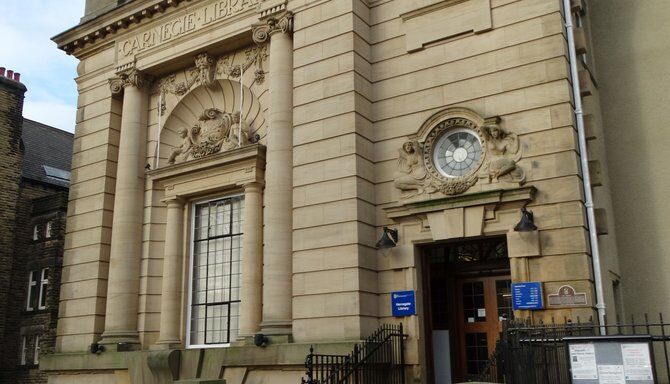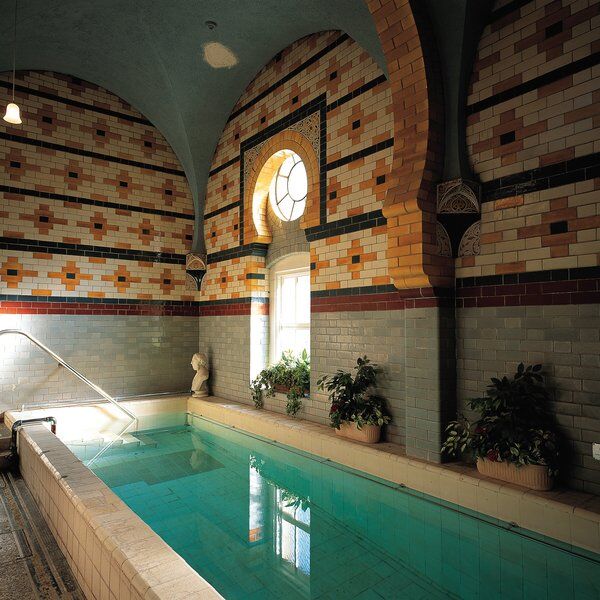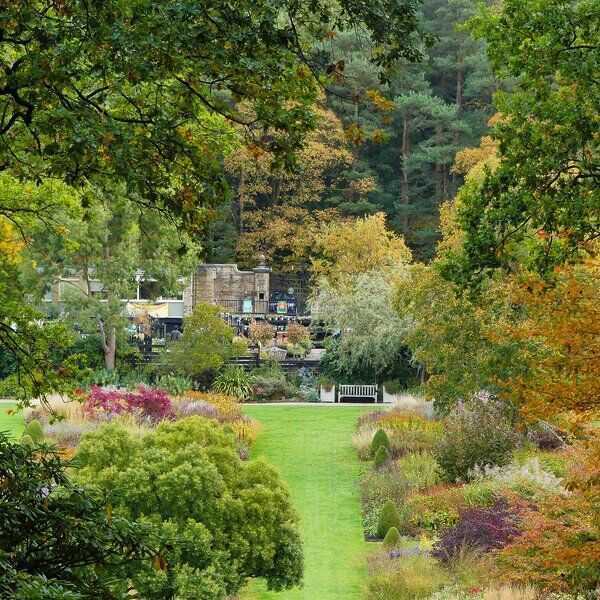Opened in 1906, Harrogate Library was designed by Henry T Hare and largely funded by Andrew Carnegie, a Scottish-American businessman with a whopping library legacy of his own.
The history of libraries in Harrogate and access to literature is a fascinating tale of twists and turns. From the first public library on Princes Street and the subversive circulating and subscription libraries across the town to present-day Harrogate Library on Victoria Avenue, Harrogate Library is a lasting memory of the working classes’ access to reading materials and the town’s social history.
The Making of Harrogate Library
When it was built, Harrogate Library was actually supposed to be part of a much bigger ‘municipal palace’ project, mostly funded by the beneficent Andrew Carnegie, a Scottish-American businessman. Harrogate Library was designed by esteemed architect and Yorkshireman Henry Thomas Hare, who later became the president of the Royal Institute of British Architects.
It is often wrongly stated that Hare engraved or carved a hare (the animal) into his buildings as a sort of trademark, but those in search of Harrogate Library’s hare will be disappointed.
Nevertheless, when it was opened in 1906, Harrogate Library was just one of 2509 Carnegie libraries built between 1883 and 1929 across the globe. Today, it is a lasting monument to the legacy of Harrogate’s literary roots and Andrew Carnegie’s determination to make education accessible to all.

The History of Harrogate’s Libraries
Of course, the present Harrogate Library on Victoria Avenue is the main character in Harrogate’s library history - but it isn’t the only character with a tell-worthy tale.
Until the Victorian era, the idea that libraries should be made accessible to the public was unthinkable. Reading for pleasure was an exclusionary hobby, one best suited to middle and upper class men. For the working classes, books were luxury items that scarcely got a moment’s consideration. Everyone was expected to work (even children) to keep food on the table, and besides, 14 years into Queen Victoria’s reign, only 69.3% of men and 54.8% of women in Britain were literate.
Women, regardless of their class, were largely discouraged from reading and writing. Wealthy parents didn’t want their daughters to read newspapers or in some cases popular novels, which were regarded as ‘dangerous’ - the material was considered too shocking for ‘delicate’ women!
The first public library in Harrogate opened in 1867 at Fern Villa in Princes Street, sixteen years after The Public Libraries act of 1850. The Act made it possible for local governments to build and operate free public libraries, though few councils were quick on the uptake.
However, Victorians didn’t have to choose between the new, pioneering free public library system and purchasing books of their own. From the middle to the end of the 19th century, subscription and circulating libraries began popping up all over the place, offering patrons a middle ground that paved the way for today’s libraries to stock all manner of books - and make them accessible to all, regardless of age or gender.
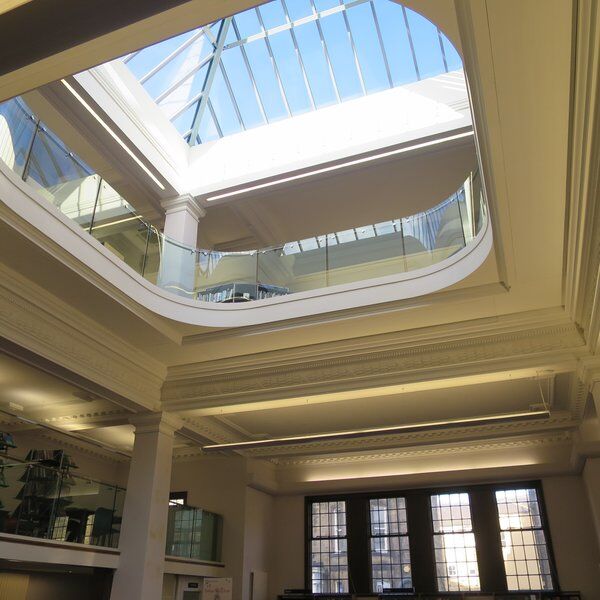
Harrogate’s Subscription and Circulating Libraries
Subscription and Circulating Libraries became a nationwide trend in Britain in the 18th century. Both were common and extremely popular in Harrogate during the 19th century, especially with tourists; temporary visitors could take out a season subscription which gave them access to reading materials during their stay.
Subscription libraries operated on the basis of a member paying an annual fee, thereafter getting access to educational material such as nonfiction essays, fossils, maps, scientific instruments and minerals.
Circulating libraries on the other hand mostly bought multiple copies of popular fiction and loaned them to anyone for a fee. Women, in particular, turned to circulating libraries to get their hands on a juicy romance or grotesque gothic horror novel.
Perhaps most interestingly, circulating libraries doubled as publishers, where especially female authors would publish their works under a pseudonym. Cleverly, circulating libraries often operated in ‘female-dominated’ shops such as haberdasheries or chemists, a trend that continued well into the 20th century.
WH Smith and Sons, still a famous brand in Britain today, operated a ‘library scheme’ from 1860 until 1961. Boots The Chemist, also a recognisable British company, took over from WH Smith and continued their ‘Book Lovers Club’ until 1966. At the height of their popularity in England, 450 Boots stores operated the scheme - and one of them was in Harrogate.
The history of Harrogate’s circulating and subscription libraries was largely buried until 2022 when a former Chinese takeaway on Leeds Street underwent refurbishment, revealing a long-forgotten sign of a former subscription library in the town. ‘Liberty Library’ was a subscription library that operated in Harrogate from the 1930s until the 1970s, and was especially popular with women and children.
Harrogate Library Reigns Supreme
As times changed and attitudes towards public amenities modernised, subscription and circulating libraries were seen by many as an unnecessary expense. After all, some began to wonder why they should pay to rent a book when their local library could loan it to them for free?
Following the breakdown of class and gender divisions, public libraries became the go-to place for much more than ‘just’ books - although reading remains as popular and as important as ever. As technology improved, public libraries offered the public the chance to use a computer, printers, photocopiers and now free WiFi.
Books were no longer the only items library members could take home with them, either. Records, cassette tapes, CDs, videos, DVDs and BluRays made popular culture accessible to whole communities. Likewise, community initiatives began to use libraries as friendly meeting spaces.
In modern times, libraries have become increasingly important for local communities to receive advice from charities and councils. During the recent cost of living crisis, North Yorkshire Council allocated Harrogate Library as a place to receive advice for people struggling with paying their bills.
Today, Harrogate Library offers thousands of books to children of all ages, as well as housing important local archives for amateur genealogists and historians. According to recent statistics, 237,100 books and e-books were taken out of Harrogate Library during the 2022/23 financial year, and a staggering 177,629 visits were made by local residents.
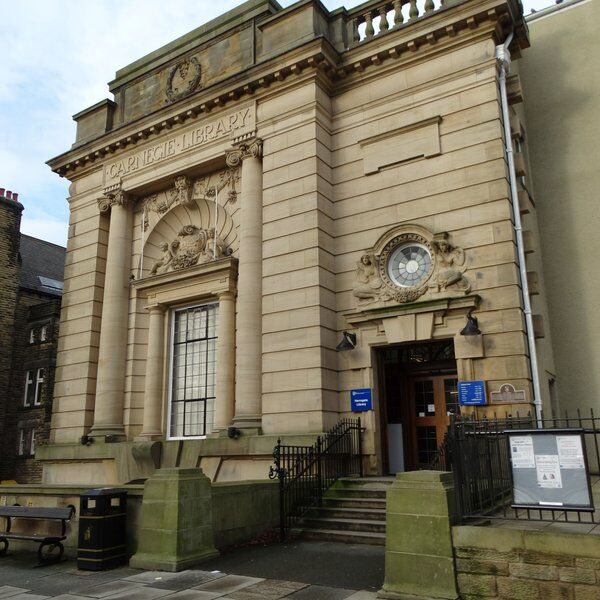
Andrew Carnegie’s Library Legacy in Harrogate
“The man who dies rich dies in disgrace” - Andrew Carnegie
Andrew Carnegie was born in Dunfermline, Scotland to penniless parents. The family emigrated to the United States when Andrew was just a small boy, but he never forgot his British roots.
At the age of 17, Andrew found himself working in a textile mill in Pittsburgh, his new hometown, unable to afford the $2 subscription to the local library. Even if he had had the money, that particular library was only open to apprentices.
But even if library access had been denied him, the hardworking and literary loving Carnegie wasn’t one to give up. After decades of hard work, Andrew Carnegie built Pittsburgh Carnegie Steel Company. When he sold the company in 1901 for $303,450,000 (around $10 billion in today’s money) he was briefly the richest man in the world.
Remembering his humiliating and aggravating rejection from his local library, Carnegie set out on a mission that would keep his name alive for centuries to come. He gave over $1 billion to libraries across the United States - and also huge sums to build libraries in neighbouring Canada and back ‘home’ in Britain too.
The first ‘Carnegie Library’ was built in Dunfermline, Carnegie’s ancestral hometown. Over the years, Carnegie funded 1,700 libraries across the United States, 800 of which are still functional libraries.
In the UK, Carnegie libraries can be found across the country, from London and Manchester to Birmingham - and, of course, Harrogate Library. It’s believed that when the first Carnegie library opened in Britain in 1883, only 23% of the UK population had access to a public library. By 1915, this number had increased to 60%, in no small part thanks to Carnegie’s generous donations.
Visiting Harrogate Library
Today, Harrogate Library offers a wide range of services and hosts numerous events and club meetings.
As well as the chance to discover fantastic books, Harrogate locals can attend reading groups, browse family history archives, read magazines and newspapers and make the most of the library’s free public wifi.
Regular group meetings also take place at Harrogate Library covering a range of interests and topics, including English language conversation class, coffee and conversation, all aboard games group, crafty ladies and code club. Amazingly, they are all free to attend!
Find out more about Harrogate Library here.

Discover More about Harrogate
Discover more about Harrogate the best way - by seeking out its hidden secrets, cultural curios and concealed nooks yourself!
By far the most fun and efficient way to learn about the spa town is by taking on CityDays’ original urban exploration game, A Peek Into The Past.
Our trail, A Peek Into The Past, combines the fun of an outdoor treasure hunt with the historical facts and whimsical trivia of a walking tour.
This route will have you solving riddles, untangling puzzles and learning more about Harrogate’s fascinating history in a new and interactive way.
Take the stress out of planning your visit to Harrogate and book your adventure today!
Not visiting Harrogate this time? Don’t worry, you’ll find us all over the world.
